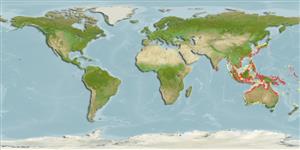Environment: milieu / climate zone / depth range / distribution range
Ecologia
marino; salmastro; distribuzione batimetrica 0 - ? m. Tropical
Western Central Pacific: replaces the coastal Hyporhamphus (Hyporhamphus) limbatus in waters around Java, Sumatra, Borneo and the Philippines. Also known from the middle of the eastern coast of Queensland, Arnhem Land, Northern Territory, and the northern part of Western Australia, and from offshore islands (Ref. 10988).
Length at first maturity / Size / Peso / Age
Maturity: Lm 12.6, range 10 - 14.9 cm
Max length : 16.5 cm SL maschio/sesso non determinato; (Ref. 9843)
Spine dorsali (totale) : 0; Raggi dorsali molli (totale) : 13 - 16; Spine anali: 0; Raggi anali molli: 14 - 17; Vertebre: 47 - 53. Gill rakers usually 31 or fewer on the first arch, and usually 23 or fewer on the second arch.
Occasionally marketed fresh in the Philippines.
Life cycle and mating behavior
Maturities | Riproduzione | Spawnings | Egg(s) | Fecundities | Larve
Collette, B.B., 1974. The garfishes (Hemiramphidae) of Australia and New Zealand. Records of the Australian Museum 29(2):11-105. (Ref. 10988)
IUCN Red List Status (Ref. 130435)
Threat to humans
Harmless
Human uses
Strumenti
Special reports
Download XML
Fonti Internet
Estimates based on models
Preferred temperature (Ref.
123201): 24.6 - 29.3, mean 28.6 °C (based on 2489 cells).
Phylogenetic diversity index (Ref.
82804): PD
50 = 0.5000 [Uniqueness, from 0.5 = low to 2.0 = high].
Bayesian length-weight: a=0.00339 (0.00181 - 0.00635), b=3.06 (2.90 - 3.22), in cm total length, based on LWR estimates for this species & Genus-body shape (Ref.
93245).
Trophic level (Ref.
69278): 3.0 ±0.4 se; based on size and trophs of closest relatives
Resilienza (Ref.
120179): Alto, tempo minimo di raddoppiamento della popolazione meno di 15 mesi (Preliminary K or Fecundity.).
Fishing Vulnerability (Ref.
59153): Low vulnerability (10 of 100).
